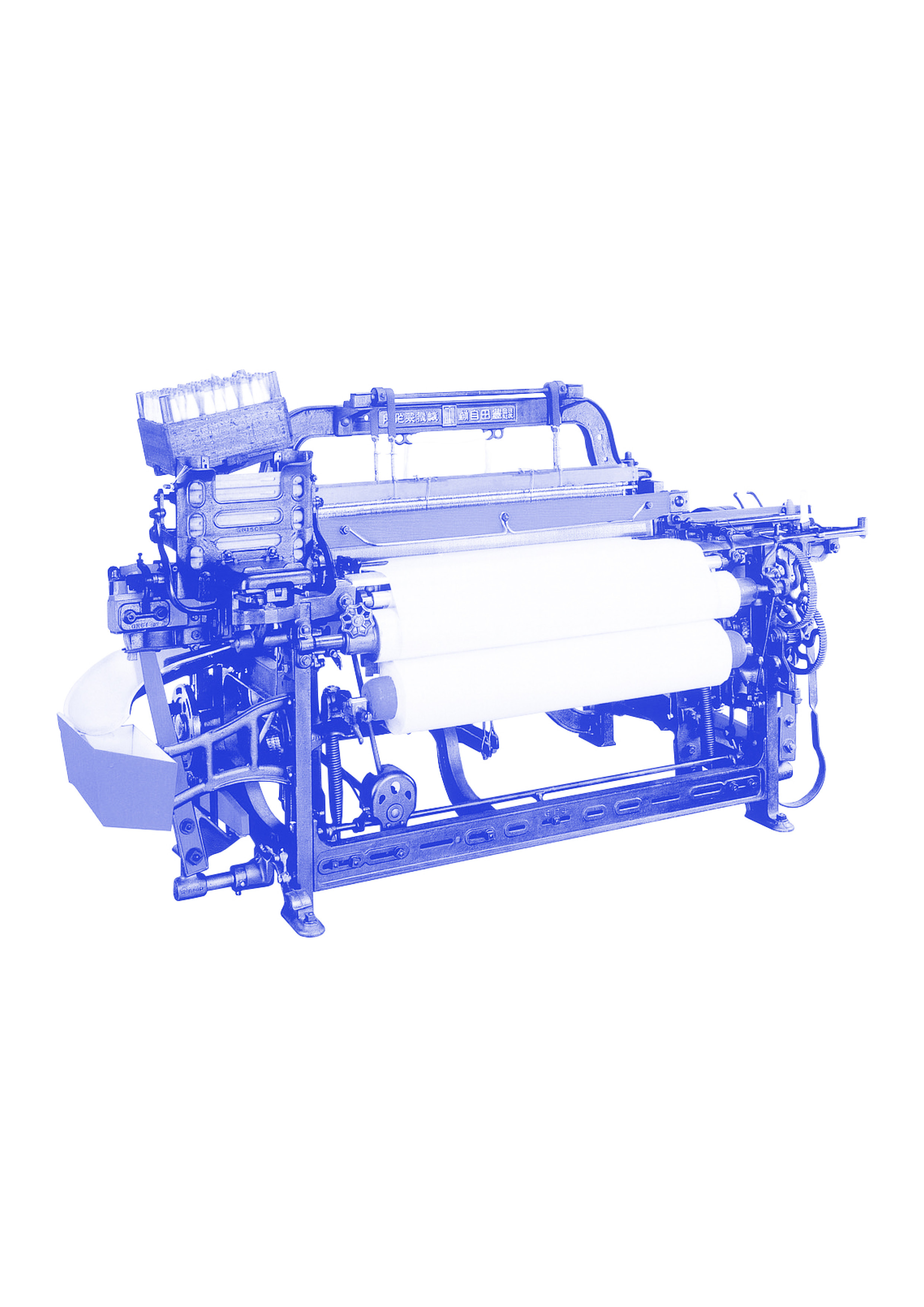
Toyoda Automatic Loom Works, Ltd.
Institution, Fashion, Production, Consumption, National, Textile, Economy, Image
The history of textile production in Japan is rich and complicated. Techniques and styles have historically travelled along the silk road and via Dutch and Portuguese ships, to find new leases on life across the Japanese archipelago.1 Franco-Japanese relations in particular have had a profound impact on the formation of a modern textile industry. The collective efforts of both countries resulted in the establishment of the Tomioka Silk Mill, the first silk reeling factory in Japan, in 1872. Its location in Gunma Prefecture was selected for the pre-existing regional tradition of silkworm farming, its ideal climate, the abundance of fresh water, its advantageous connection to the port of Yokohama, and – notably – the presence of coal to power the machines. From the Tomioka factory, knowledge and skill spread throughout Japan, and textile manufacturing became Japan’s largest industry.2
Born just before the foundation of the Tomioka Silk Mill, Sakichi Toyoda saw an opportunity in improving the hand looms used by local cotton farmers. Inspired by machines from around the world, exhibited at the Third National Machinery Exhibition in Ueno, Tokyo, Toyoda created a new type of hand loom that would get him his first patent in 1891. In the years and decades that followed, Sakichi Toyoda dedicated himself to inventing and developing power driven looms. He visited Manchester and the American East coast to study existing machinery, to create the best possible device himself. When he launched an automatic loom in 1926, it soon found worldwide success. Toyoda Automatic Loom Works, Ltd. was established, and the European marketing and production rights of the new machine were sold to Platt Brothers & Co. in England. It would turn out to be a decisive event for Japanese industry, as the proceeds of the sale were invested in the research and development of a new branch: automobiles. What would become Japan’s largest company, Toyota Motor Corporation, was born from the textile industry.3
1. Reiko Sudo, Japanese Textiles, (Tokyo: Ryohin Keikaku Co., Ltd., 2018), 96.
2. Tessa Morris-Suzuki, “Sericulture and the Origins of Japanese Industrialization,” Technology and Culture 33, no. 1 (Jan., 1992): 101-102.
3. Toyota Motor Corporation, “The Story of Sakichi Toyoda,” Toyota-Industries.com. Accessed March 8, 2020. https://www.toyota-industries.com/company/history/toyoda_sakichi/
Visit ephemera: 40, 41
Institution, Fashion, Production, Consumption, National, Textile, Economy, Image
The history of textile production in Japan is rich and complicated. Techniques and styles have historically travelled along the silk road and via Dutch and Portuguese ships, to find new leases on life across the Japanese archipelago.1 Franco-Japanese relations in particular have had a profound impact on the formation of a modern textile industry. The collective efforts of both countries resulted in the establishment of the Tomioka Silk Mill, the first silk reeling factory in Japan, in 1872. Its location in Gunma Prefecture was selected for the pre-existing regional tradition of silkworm farming, its ideal climate, the abundance of fresh water, its advantageous connection to the port of Yokohama, and – notably – the presence of coal to power the machines. From the Tomioka factory, knowledge and skill spread throughout Japan, and textile manufacturing became Japan’s largest industry.2
Born just before the foundation of the Tomioka Silk Mill, Sakichi Toyoda saw an opportunity in improving the hand looms used by local cotton farmers. Inspired by machines from around the world, exhibited at the Third National Machinery Exhibition in Ueno, Tokyo, Toyoda created a new type of hand loom that would get him his first patent in 1891. In the years and decades that followed, Sakichi Toyoda dedicated himself to inventing and developing power driven looms. He visited Manchester and the American East coast to study existing machinery, to create the best possible device himself. When he launched an automatic loom in 1926, it soon found worldwide success. Toyoda Automatic Loom Works, Ltd. was established, and the European marketing and production rights of the new machine were sold to Platt Brothers & Co. in England. It would turn out to be a decisive event for Japanese industry, as the proceeds of the sale were invested in the research and development of a new branch: automobiles. What would become Japan’s largest company, Toyota Motor Corporation, was born from the textile industry.3
1. Reiko Sudo, Japanese Textiles, (Tokyo: Ryohin Keikaku Co., Ltd., 2018), 96.
2. Tessa Morris-Suzuki, “Sericulture and the Origins of Japanese Industrialization,” Technology and Culture 33, no. 1 (Jan., 1992): 101-102.
3. Toyota Motor Corporation, “The Story of Sakichi Toyoda,” Toyota-Industries.com. Accessed March 8, 2020. https://www.toyota-industries.com/company/history/toyoda_sakichi/
Visit ephemera: 40, 41


